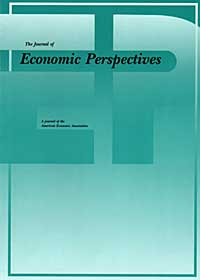What Do We Know About Environmental Justice?
Not As Much As We Should
 If you are not a regular reader of the Journal of Economic Perspectives, you should be. Most economists fetishize what my friend and colleague Steve Bainbridge refers to accurately as “recreational mathematics.” But often, these models add more heat than light, and in any event, function as a private language.
If you are not a regular reader of the Journal of Economic Perspectives, you should be. Most economists fetishize what my friend and colleague Steve Bainbridge refers to accurately as “recreational mathematics.” But often, these models add more heat than light, and in any event, function as a private language.
Fortunately enough, JEP’s magician-editor Timothy Taylor is the world’s finest translator of economics into English, producing a remarkable journal of high-quality social science research that educated laypeople can understand. And for Legal Planet, that is particularly important this quarter because of an important review article in the latest issue by Spencer Banzhaf, Lala Ma, and Christopher Timmins — Environmental Justice: The Economics of Race, Place, and Pollution — concerning what we know and more importantly what we don’t know about environmental justice.
In this paper, we review the environmental justice literature, especially where it intersects with work by economists. Although environmental justice is an interdisciplinary field, economists’ focus on causal relationships, and on linking empirical models to theoretical ones, gives them a comparative advantage in untangling the web of socioeconomic relationships involved. In the next section, we first consider in more depth the literature documenting evidence of disproportionate exposure…We particularly consider the implications modeling choices about spatial relationships between polluters and residents, and about conditioning variables. Next,we evaluate the theory and evidence for found possible mechanisms that may lie behind these patterns; disproportionate siting on the firm side, “coming to the nuisance” on the household side, market-like coordination of the two, and discriminatory politics and/or enforcement. We argue that it si unclear how much weight each of these mechanisms carry in giving rise to the observed distribution, and that much previous research uses methodologies that inherently indecisive. Further research is needed, as we cannot hope to address injustices is we do not understand their origins. Finally, we offer an overview of some policy options before concluding.
I admit that I was annoyed initially about the comments concerning economists’ “comparative advantage” – lots of disciplines do causal work using fairly straightforward statistical methods, and qualitative work also provides a lot of important evidence that “untangle[s] the web of socioeconomic relationships.” But I think that the intended audience of that line is other economists, whom the authors want to involve more in scholarly work concerning environmental justice. In general, the authors appear sympathetic to environmental justice activists, a rare trait among economists.
I thought that the article did a fine job of explaining clearly how different ways of cutting statistical data could different results, as well as identifying how many problems we normally see as “environmental justice” are simply problems of income and wealth inequality. On the former, depending upon the spatial unit of analysis, e.g. a county or a city, researchers might find either no disparate impact or a disparate impact that is essentially an artifact of the geographic unit. On the latter, if we find that polluting firms go to areas with more poor people because land values are lower, the answer to that (at least in an ideal world) is to get the poor people more money: as the authors note, polluting firms and poor people might well be sorting efficiently – given the underling distribution of resources. The authors also present a solid and succinct survey of the question of whether environmental enforcement is lower in low-income communities of color – an area that seems understudied by legal scholars and could use more qualitative research.
Finally, even though the authors make the now-cliched call for more research, they advocate for what they call “no-brainer” policies for giving environmental justice advocates a seat at the table, especially since that can enhance local communities’ position in the Coasean bargaining that legal frameworks often enable. I continue to believe, as I argued for in my recent article on environmental justice in India, that a big part of giving subordinated communities a seat at the table lies in capacity-building. Until and unless low-income communities have the capability of identifying their needs and developing processes for advancing those needs, seats at the table might very well go to self-appointed leaders or to no one in particular.
But that is for another day. It’s a good piece, with an excellent review of literature, and as noted above, written in English. Important to check out for those interested in environmental justice — especially because, as the authors show, we still don’t know as much as we should.








Reader Comments